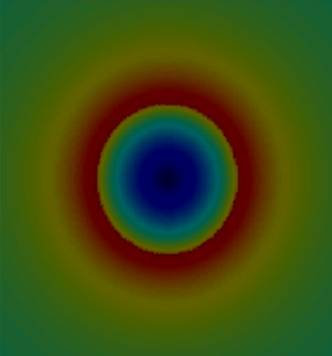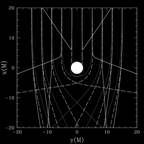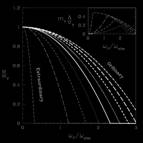

Ongoing ResearchPolarized Radiative Transfer Near Black Holes |
|
Spectropolarimetry provides an important additional tool for probing astronomical environments. With the advent of high-resolution monitoring of the polarized (both linear and circular) spectra of galactic nuclei, it is possible to use polarization to inform our modeling of the accretion flows in these regions. have been primarily focused upon understanding the polarization of radio and near-infrared emission associated with the super-massive black hole in the Galactic center (Sgr A*) and analogous systems. The circular polarization of Sgr A* is surprising in three respects. First, unlike most other astrophysical cases, there is no linear polarization at the frequencies the circular polarization has been observed. Second, the circular polarization fraction spectrum is inverted, that is the circular polarization fraction increases with frequency. Third, while the circular polarization fraction is highly variable, it is uncorrelated with the variability in the unpolarized spectrum, and it’s sense has been constant for decades. While there aren’t any other systems that have been studied in the detail that Sgr A* has, circular and linear polarization observations of other AGN have found circular polarization fractions that are uncorrelated with the linear polarization or unpolarized flux. This suggests that the mechanism responsible for the polarization in Sgr A* may not be restricted to the Galactic center (or low luminosity AGN in general). With Roger Blandford, there are two ways in which I have tried to understand the polarization properties of Sgr A*. The first of these involves refraction in magnetized plasmas around black holes and the selective capture of one polarization mode. The second involves the coupling of the polarization propagation to the shearing of the magnetic field, presumably due to the differential rotation of an accretion disk.
|
|
Imaging BHs | The Nature of BHs | WD-CO Binaries | GRBs | Star Formation | Polarized RT | Magnetized NSs | Rotation Measures |
|
Papers on this topic: Broderick, A.E., 2006, MNRAS, 366, L10 Broderick, A. & Blandford, R., 2004, MNRAS, 349, 994 Broderick, A. & Blandford, R., 2003, MNRAS, 342, 1280
|
|
Home | Research | Publications | In the News | Pictures |



|
The Extraordinary mode (solid) is refracted more than the Ordinary mode (dashed) which is refracted more than the null geodesics (dotted). (Shown for a Bondi flow.) |
|
The capture cross-section for the Extraordinary mode is substantially smaller than that of the Ordinary mode near the plasma frequency. This alone can create polarization fractions of ~50%! (Shown for a Bondi flow.) |
|
An image of the circular polarization fraction (blue and red are 100% polarized in opposite senses). |

